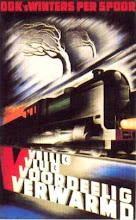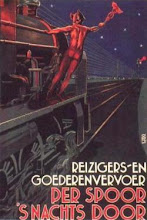The Lionel 151 semaphore is a postwar accessory that is usually wired with a Lionel 153 contactor. This will lower the semaphore for a few seconds when a train passes and then it flips back. However, in case you do not have such a contactor, you need to think of something else. This took me a while. But I found that the Finder 26.01 impulse relay is well suited to do the job.
For the moment I use a contact switch to the impulse relay, but I am busy to place two reed contacts between the rails to switch the relay.
The first tests with the reed contacts were good. I just have to form two wooden blocks to position them on the correct height, so that they are in close proximity to the magnets under the engines.
The only downside of the Lionel 151 semaphore is the large amount of current that runs through its electromagnetic coil to engage the signal arm downwards. It does sound like something is getting toasted. True old-fashioned tin-plate! Luckily it doesn't smell toasted.
Sunday, January 24, 2016
Monday, January 11, 2016
Merkur mounting bridges
Today I assembled the Merkur 8989 mounting bridge. It came in a new style box; white corrugated board with an glued inlay of a superfluous ad from the past.
Quiet a significant change for Merkur.
The instructions are in good old Czech language, nevertheless the shape of the parts are crystal clear to me.
The six parts are all metal (what else?). But surprisingly the connections were slots and tabs. Not a single screw, nut or washer in this Merkur kit. Something changed here. This is true tin-plate.
Besides that this mounting bridge is a beautiful piece of decoration, it appears to also bear a function. It is used for hanging signals over the tracks. Although there is nothing to hang on, yet. I do appreciate this mounting bridge. Although it cannot really be a bridge, since it will basically only proceed to half-way over the tracks.
The Merkur 8988 is the larger mounting bridge that can span two tracks and is actually a bridge. It comes in a traditional Merkur box that is also used for train cars and the assembly is comparably simple. And in case I forgot to mention it, it looks stunning.
Quiet a significant change for Merkur.
The instructions are in good old Czech language, nevertheless the shape of the parts are crystal clear to me.
The six parts are all metal (what else?). But surprisingly the connections were slots and tabs. Not a single screw, nut or washer in this Merkur kit. Something changed here. This is true tin-plate.
Besides that this mounting bridge is a beautiful piece of decoration, it appears to also bear a function. It is used for hanging signals over the tracks. Although there is nothing to hang on, yet. I do appreciate this mounting bridge. Although it cannot really be a bridge, since it will basically only proceed to half-way over the tracks.
The Merkur 8988 is the larger mounting bridge that can span two tracks and is actually a bridge. It comes in a traditional Merkur box that is also used for train cars and the assembly is comparably simple. And in case I forgot to mention it, it looks stunning.
 |
| Merkur 8989 mounting bridge on the left hand side and Merkur 8988 mounting bridge on the right hand side. |
Subscribe to:
Comments (Atom)














